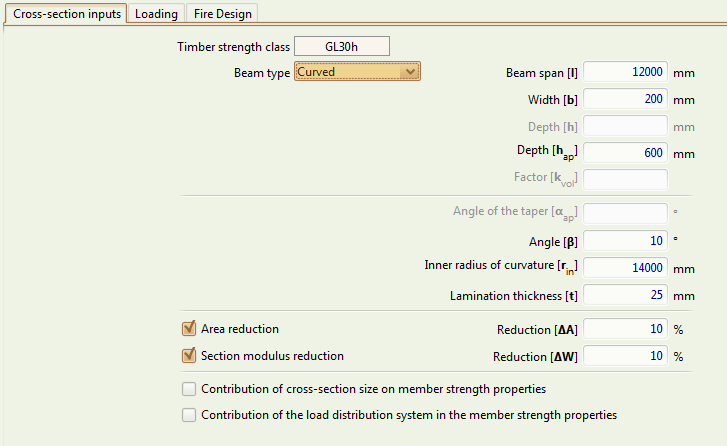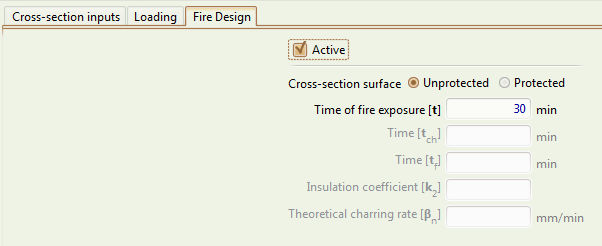Double tapered, curved, or pitched-cambered beams
This refers to glulam or LVL beams of a rectangular cross-section whose geometry changes symmetrically along its axis. These can be double tapered, curved, or pitched cambered beams.
The design is checked for bending about the y-y axis, taking into account the effect of local bending, shear, and tensile (perpendicularly to the grain) stresses at the apex, according to Clause 6.4.3.
All references to EN 1995-1-1:2004+A2:2014 unless otherwise stated.
Cross-sectional Inputs tab

Timber strength class
The timber strength class of the cross-section. This design case supports only glulam and LVL classes.
Beam type
The user can selected between double tapered, curved, and pitched cambered beams.
Beam span
The span of the beam, in .
Width
The width of the cross-section, in .
Depth
The depth of the cross-section, in .
Depth
The depth of the cross-section at the apex, in .
Factor
The volume factor is required for Kerto-Q LVL where all veneers are not parallel to the beam axis.
Angle of the taper
The angle of the taper in the apex zone for a double-tapered or pitched-cambered beam, in degrees.
Angle
The angle of a curved beam in the middle of the apex zone, in degrees.
Inner radius of curvature
This is the radius of curvature of the beam, measured to the centre of gravity of the beam, in .
Lamination thickness
The lamination thickness, in .
Area reduction
The area reduction refers to reductions in the nominal cross-section size that have to be taken into account in the calculation of the member strength (e.g. holes from fasteners) according to Subclause 5.2(2).
It should be given as a percentage of the total nominal area of the cross-section.
Section modulus reduction
The section modulus reduction refers to reductions in the nominal cross-sectional modulus that are to be taken into account in the calculation of the member strength (e.g. holes from fasteners) according to Subclause 5.2(2).
It should be given as a percentage of the total nominal section modulus of the cross-section.
Contribution of cross-section size on the determination of member strength properties
Includes factors for the calculation of the member strength in solid timber, glulam and LVL, according to Clauses 3.2, 3.3, and 3.4.
In the case of an LVL member under tension, the member length is also required.
Contribution of the load distribution system in the member strength properties
Includes factor for the calculation of the member strength, according to Clause 6.6, for a member that functions as part of a continuous load distribution system.
Note that Subclause 6.6(3) states that the strength verification for a continuous load distribution system should be carried out assuming short-term load duration.
Loading Inputs tab

Design bending moment
The design bending moment about the y-y axis in the apex zone, in .
Design shear force
The design shear force in the apex zone, in .
Load duration class
The Load Duration Class, as defined in Clause 2.3.1.2.
Service class
The Service Class, taking into account the temperature and relative humidity of the environment, as described in Clause 2.3.1.3.
Factor taking into account the effect of the duration of the loads and the moisture content, according to Clause 3.1.3.
Fire Design tab

Active
Selects if this cross-section will also be designed against fire.
Cross-section surface
Defines if the cross-section surface is unprotected (exposed to fire on all sides) or is protected (on all sides).
Time of fire exposure t
The time of the exposure of the cross-section to fire, in minutes.
Time
The time of exposure of a protected cross-section to fire until it starts to char, in minutes.
Time
The time of exposure of a protected cross-section to fire until the protection fails completely, in minutes.
Note that this is can be longer (but not shorter) than .
Factor
Factor defines the charring rate of a protected cross-section between the time it starts to char and the time the protection fails completely.
It is required when has a different value to .
Theoretical charring rate
The theoretical charring rate of the timber, in mm per minute.
It is required for plywood where the relevant standards do not provide a default value.